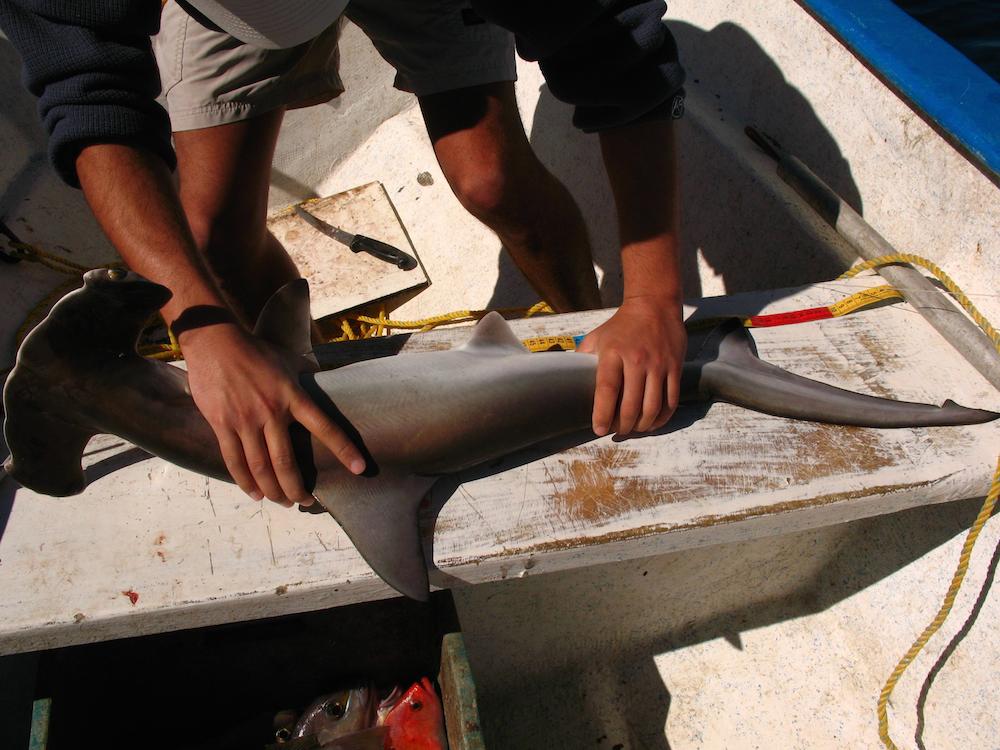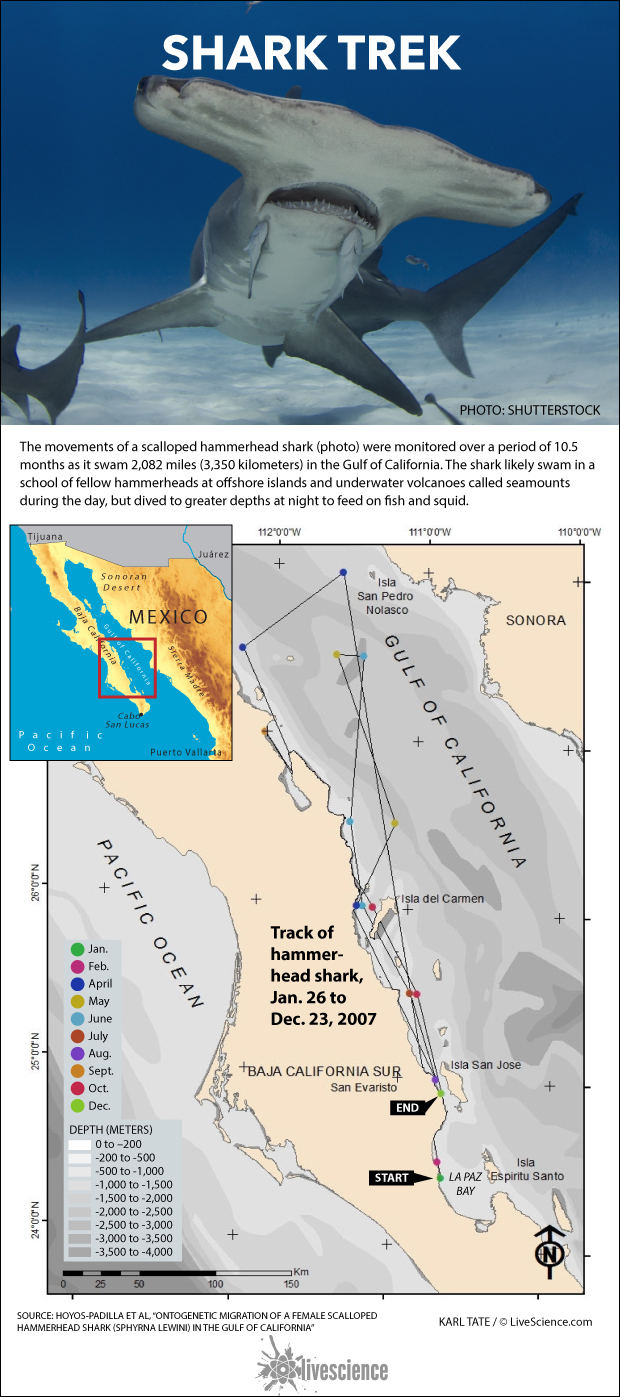Map of Endangered Shark's Wanderings Could Aid Conservation

A young hammerhead's 10.5-month journey through the Gulf of California reveals that the endangered shark often swam outside of protected areas, according to a new research that suggests key areas where protection could help the species survive.
After hitching rides from local fishermen, researchers caught and tagged three young scalloped hammerhead sharks (Sphyrna lewini) in the Gulf of California, which separates the Baja California peninsula from mainland Mexico.
Maps of the sharks' wanderings could help conservationists develop plans to protect the vulnerable species. [See photos of tagged hammerhead sharks]
Tags were attached to the base of the sharks' pelvic fins to record depth, sea temperature and light levels, which help determine the time of day, every 30 seconds. But they did not transmit the information to a satellite, meaning the researchers had to find the sharks again to collect the data.
"I spent at least five weeks going out every day from 6 a.m. to 6 p.m. with the local fishermen in La Paz Bay and Mazatlan until we were able to set at least three archival tags," said lead researcher Mauricio Hoyos, who works with Pelagios Kakunjá, a marine conservation nonprofit. Not much is known about the migratory movements of young hammerhead sharks, which makes these findings important, he added.
Of the three sharks, the researchers recaptured one, a female measuring 3.1 feet (1 meter) long when they first tagged her on Jan. 26, 2007, in La Paz Bay.
The female, likely about 3 years old based on her size, swam 2,082 miles (3,350 kilometers) over about 10.5 months. After her tagging, the shark stayed close to shore for 20 days. By early February, she began swimming northward along the coast, before venturing out into offshore waters and returning to La Paz Bay, where fisherman found her on Dec. 23, 2007.
Sign up for the Live Science daily newsletter now
Get the world’s most fascinating discoveries delivered straight to your inbox.
The shark's migration fits with what researchers know about hammerhead sharks, said study co-author Pete Klimley, who has studied hammerheads since the 1970s, and directs the biotelemetry laboratory at the University of California, Davis.
Typically, baby hammerheads stay in coastal nurseries during their first one or two years of life. Males tend to stay inshore longer, but females venture out when they turn 3 or 4 years old, Klimley said.
During the day, juvenile and adult females swim in schools near islands or seamounts, which are small underwater volcanoes that are either inactive or extinct. But at night, the sharks tend to swim off on their own, diving deep into pelagic, or deeper, ocean waters to catch squid.

"The females move offshore earlier to form these schools and brave the predator-rich environment of the pelagic ocean to maximize growth," Klimley told Live Science. [On the Brink: A Gallery of Wild Sharks]
Males may choose mates who are larger and dominant within the school, which gives the females a good reason to stuff themselves and jockey for a high social rank. "They do this because they want to bulk up, they want to get big so that they can be an adult and reproduce," Klimley said.
Just keep swimming
The female hammerhead's swimming patterns echo earlier findings. It's likely she left the coast to find food that would help her grow, the researchers said. After swimming offshore, she remained in warm, shallow waters that are less than 100 feet (30 m) deep. At night, she made repeated dives into colder waters at depths of about 820 feet (250 m).
The young shark's route may help researchers design future management plans to protect hammerheads, Hoyos said. Increased human fishing, fueled by the global demand for shark and ray fins for shark-fin soup, has reduced hammerhead numbers to a negligible size in the Gulf of California, he said.
In Mexico, commercial fishing from large vessels is prohibited within 50 nautical miles of the coast. But, based on the female hammerhead's coastal and offshore-swimming routes, it's clear that young hammerhead sharks need more protection, the researchers said.
"You go [to the gulf] now and it's pretty much barren," said Yannis Papastamatiou, a marine biologist at the University of St. Andrews in Scotland, who was not involved in the study. "You may see a few hammerheads if you're lucky."
But researchers need to track more sharks before they can designate protected areas, he said.
"It's a [study] size of one, so you've got to be very cautious about what you say," Papastamatiou said.
Studying fishermen tactics and catch numbers may also help protect hammerheads, said Juan Carlos Pérez Jiménez, a professor of marine biology at El Colegio de la Frontera Sur in Campeche, Mexico, who was not involved with the study.
"If you put the regulation, you need to know the behavior of fisherman," Pérez Jiménez said. "How they act, how they use the fishing gear."
The study was published Tuesday (Nov. 25) in the journal Animal Biotelemetry.
Follow Laura Geggel on Twitter @LauraGeggel. Follow Live Science @livescience, Facebook & Google+. Original article on Live Science.

Laura is the archaeology and Life's Little Mysteries editor at Live Science. She also reports on general science, including paleontology. Her work has appeared in The New York Times, Scholastic, Popular Science and Spectrum, a site on autism research. She has won multiple awards from the Society of Professional Journalists and the Washington Newspaper Publishers Association for her reporting at a weekly newspaper near Seattle. Laura holds a bachelor's degree in English literature and psychology from Washington University in St. Louis and a master's degree in science writing from NYU.










